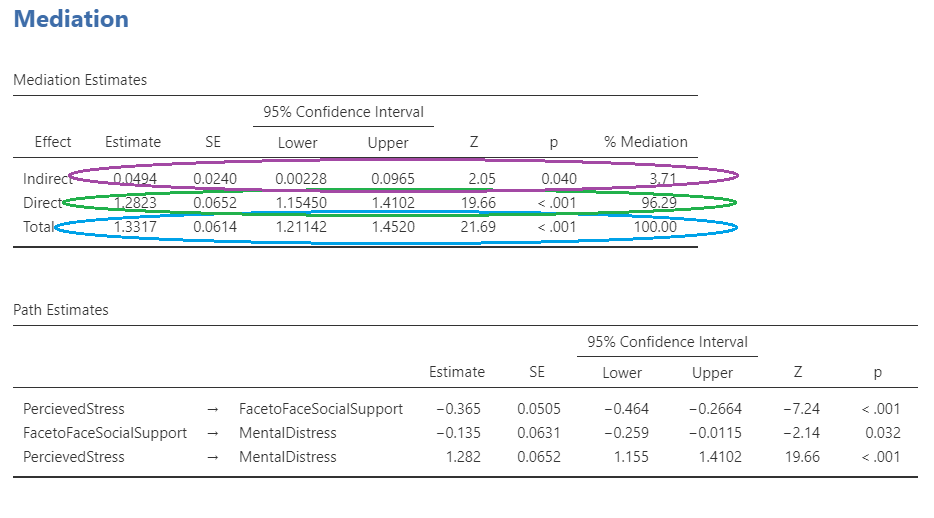Section 7.2: Mediation Assumptions, The PROCESS Macro, Interpretation, and Write Up
Learning Objectives
At the end of this section you should be able to answer the following questions:
- Explain the assumptions that should be met before performing a mediation analysis.
- Explain the PROCESS Macro.
- What are the main ideas to focus on in mediation interpretation?
Mediation models focus on two effects – the direct effect and the indirect effect – and these can be combined into a measure of the model’s total effect.
Effects in a Simple Mediation Model
Using the prior example of the effects of conscientiousness and physical health, the indirect effect is the product of a and b = ab, from the previous figure. This is the indirect effect of the pathway from X to M, and M to Y. The total model effect is the combined direct effect and the indirect effect. The total effect quantifies how much two cases that differ by one unit on X are estimated to differ on Y.
Mediation Assumptions
There are a number of assumptions that should be met before performing a mediation analysis.
- The dependent, independent, and mediator variables (the variables of interest) need to be using a continuous scale.
- The variables of interest (the dependent variable and the independent and mediator variables) should have a linear relationship, which you can check with a scatterplot
- The data must not show multicollinearity (see Multiple Regression).
- There should be no spurious outliers, and the distribution of the variables should be approximately normal.
The MedMod Macro
The advent of affordable personal computers with statistical software has prompted researchers to develop new tools for analyses. Jamovi provides a number of free modules for more advanced analyses, including the MedMod Macro for meditation and moderation. Another tool for mediation analyses is the PROCESS Macro, which is available as a free extension for SPSS.
PowerPoint: Hayes PROCESS Macro
The following slide provides information on MedMod by illustrating where it appears in the Jamovi menu, and by showing menu option:
Mediation Interpretation
PowerPoint: Mediation Menu and Results
The linked slides provide an example of mediation output:

The total effect of the model can been seen in blue, with the direct effect (i.e. X and Y) in green. The indirect effect can be seen in purple, with the p value for the indirect effect can be found in orange. Now the interpretation of many of these statistics (p values etc) has been explained in previous lessons, but the main thing to focus on is the direct and indirect effects. If the direct effect is significant, then X does effect Y, and if there is a significant indirect effect then M does indeed mediate the relationship between X and Y.
Mediation Write Up
This mediation output results can be written up as follows:
A mediation analysiswas conducted to examine the mediating effect of social support on perceived stress and mental distress. The total effect of the model was found to be significant, b=1.33, z=21.69, BCa CI [1.21, 1.45], p<.001. It was found that there was a statistically significant direct effect, b=1.28, z=19.66, BCa CI [1.15, 1.41], p<.001. A statistically significant indirect effect was also found, b=0.05, z= 2.05, p=.040. These results suggest that social support partially mediated the relationship between perceived stress and mental distress

